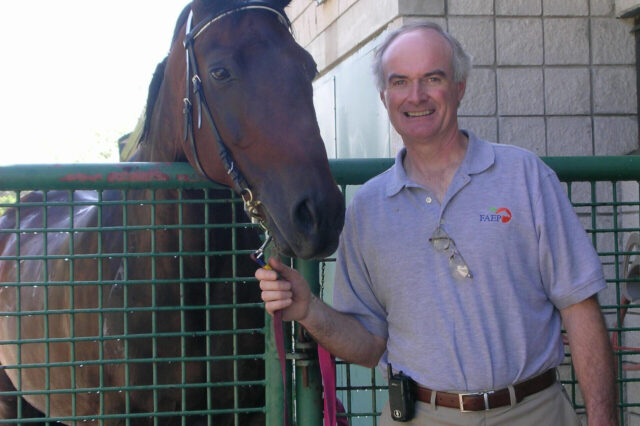Brazilian olympic team horse recovers after treatment at UF

Dr. David Freeman with Livello on April 11 prior to the horse's release from UF's Alec P. and Louise H. Courtelis Equine Hospital. Livello spent months at UF and underwent three surgical procedures to address complications from an extracted tooth. (Photo by Sarah Carey)
After surviving an odyssey of complicated medical problems and difficult surgeries, a Brazilian Olympic dressage horse named Livello has lived to train another day and is recuperating back in his home country, thanks to University of Florida veterinarians.
UF equine surgeon David Freeman, who played a key role in Livello’s amazing story and eventual turnaround, discharged the horse on April 11 to one of his Brazilian veterinarians, who flew home with him.
“This horse is all quality,” Freeman said. “Everyone who dealt with him here did a wonderful job, and this is a horse that came all the way from Brazil because we had the technology to treat him.”
Freeman said Livello’s case illustrated the importance of powerful imaging equipment, particularly UF’s MRI unit, in guiding effective medical treatment.
“Livello actually came here because the owners were aware we had CT and thought that could be used to help him, but it turned out that the MRI was a better imaging tool for his problem,” Freeman said.
Brazilian veterinarian Fernanda Bicudo Cesar said the horse’s owner, Dr. Jorge de la Rocha, and his family were “very thankful for everyone involved.”
Cesar spent two weeks at UF with Livello when his primary veterinarian, Patricia Brossi, had to return home after spending two months in Gainesville.
Brossi said Livello was a fighter, and so much more than that to those who know him.
“You have only to go through his medical records to appreciate how much of a fighter he is,” she said. “Besides that, he talks to you, he makes it really clear how much he appreciates everything you do for him.
“Livello is the horse we dreamed of back in our childhood, when we first realized we loved horses, those huge creatures, their smell, the noise from their hooves, the feeling of being on top of them,” Brossi said. “He is special to Dr. Jorge because he fits him, with his size and his personality, as no other horse ever did.”
Livello’s story began in Brazil last October with a bad tooth. A tooth extraction procedure damaged the horse’s tear duct and intraorbital nerve, veterinarians said.
“Tears were coming down his face, and he had nerve damage that was causing him to rub his face and sneeze,” Freeman said, adding that a subsequent procedure involving a veterinary surgeon from Tennessee and a world-renowned equine dentist who were flown to Brazil to help did not resolve the problem.
“The surgeries went well, but never cleared up the infection Livello had developed in his sinuses,” Freeman said.
Because of his infection, Livello subsequently developed facial swelling and a malodorous nasal discharge.
Desperate to help him, his owners and their veterinarians, who had heard of Freeman and UF’s imaging capability through veterinary meetings in Brazil, decided the horse needed to be treated at UF. In February, de la Rocha, who also has ridden Livello as part of the Brazilian Olympic dressage team, flew the horse and Brossi to UF’s Alec P. and Louise H. Courtelis Equine Hospital.
“We had some idea based on Livello’s history and clinical signs that there was probably some necrotic bone that needed to be removed,” Freeman said. “But we didn’t know the exact location or extent of it, and that is where both the CT and our new MRI unit came in.”
An initial surgery resulted in the removal of a lot of dead bone and tissue, but Livello’s sinus drainage continued, as did the nasal discharge.
“So we did another MRI on him about three weeks later and then another surgery after that,” Freeman said. “The MRI images helped us find the sites where we needed to go, and the site was not an easy area to gain access to. We were somewhat reserved by then in terms of our level of satisfaction because we knew there might still be more bone left.”
By the time Livello left, however, he had undergone three surgeries at UF, with the last one being the most difficult. Within two weeks of his last procedure, however, Livello began showing signs of improvement.
“His attitude definitely improved,” Freeman said. When Livello’s nasal discharge vanished, Freeman and his colleagues knew they had turned a corner.
“This was a tough case,” he said. “Every now and then we get cases that test us and test our general ability to handle very serious veterinary challenges and this was one of them.”
Freeman added that he gave a lot of credit to Livello’s owner, de la Rocha, for his unwavering commitment to the horse.
“He was not going to be deterred by the cost of treatment but he was realistic and committed and most of all, he did not want this horse to suffer,” Freeman said. “He wanted the very best for him, and he did all the right things. That didn’t replace any of our caregiving for the horse, but it made it a lot easier.”
About the author
